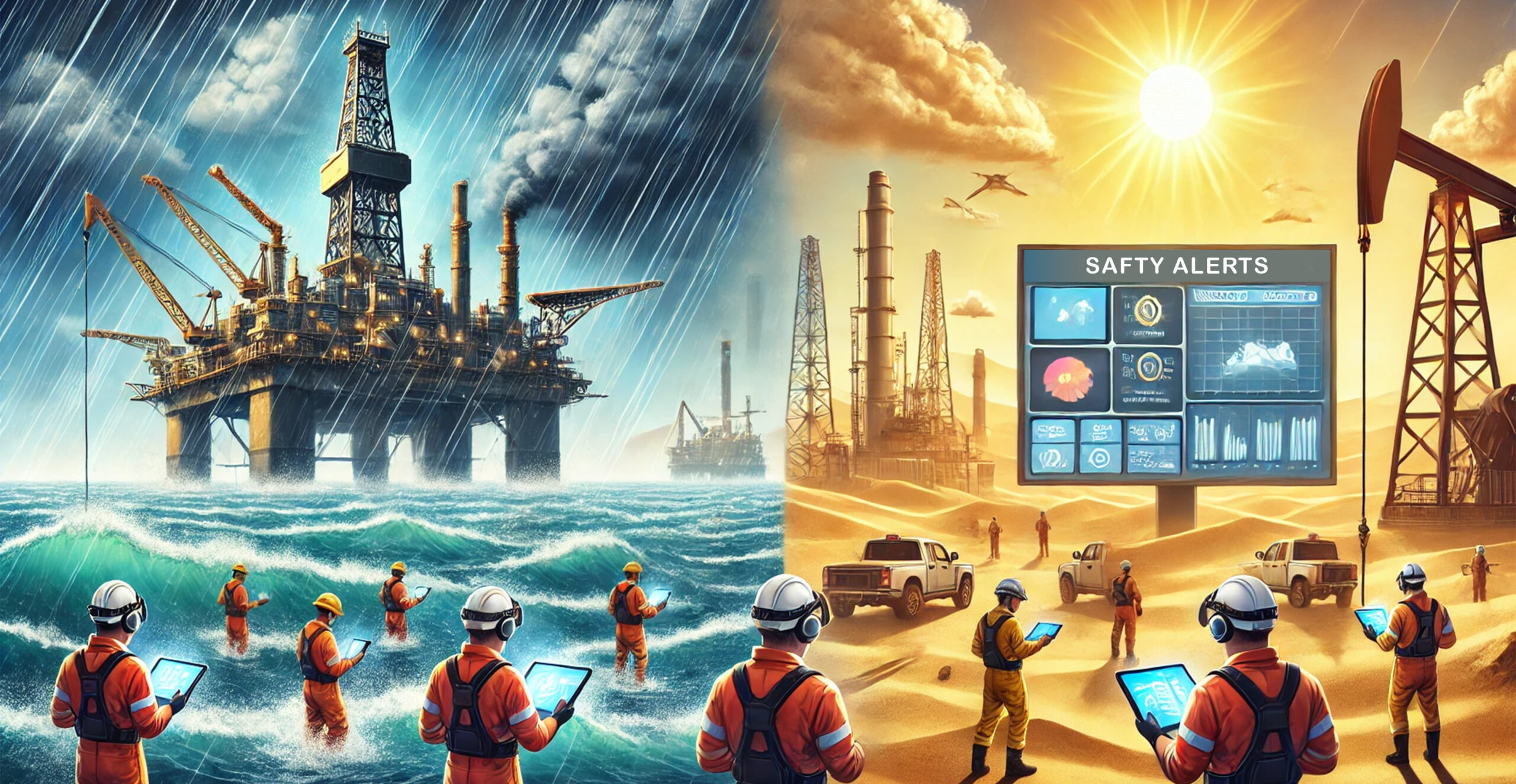
In today’s fast-moving world, good communication is a game-changer across industries—whether it’s helping students learn, doctors save lives, or keeping oil and gas operations running safely. In such a high-risk field, where teams work in tough conditions and every decision matters, staying connected isn’t just helpful—it’s essential.
Digital signage is revolutionizing communication in the oil and gas industry, much like real-time data systems in finance. By replacing static, paper-based messages with dynamic digital displays, companies ensure workers receive instant, precise information, enabling swift responses in high-pressure environments. This blog explores how Digital Communication Systems enhance internal communication, ensuring critical information reaches the right people at the right time—boosting both safety and operational success.
Table of Contents
- The Challenges in the Oil and Gas Industry: Communication and Safety Concerns
- What Exactly is Digital Signage?
- The Role of Digital Signage in Oil and Gas Operations
- The Transformation: How Digital Signage is Changing the Oil and Gas Sector
- Key Benefits of Dynamic Signage in Oil and Gas Operations
- Conclusion: A New Era of Communication in Oil and Gas
The Challenges in the Oil and Gas Industry: Communication and Safety Concerns

The oil and gas industry is one of the most complex and high-risk sectors in the world. Spanning large geographical areas, from offshore drilling platforms to remote desert operations, communication in this environment is far from simple. The unique challenges faced by oil and gas companies can range from hazardous working conditions and long distances between teams to time-sensitive decisions that require seamless coordination.
Unlike in other sectors where communication happens within more controlled environments—such as offices or classrooms—the oil and gas industry often involves workers spread across isolated sites where traditional methods of communication just don’t cut it. Operators are constantly balancing safety protocols, regulatory requirements, and the need for real-time updates on changing conditions. Without reliable communication tools, there’s a heightened risk of errors, accidents, and inefficiencies.
In this section, we’ll unravel these challenges and set the stage for how digital signage has emerged as a game-changing tool to bridge communication gaps and enhance efficiency in this high-risk sector.
What is Digital Signage?
Have you ever walked into a store or a fast-food chain like McDonald’s and noticed the large screens displaying menus, promotions, or real-time information? Or perhaps you’ve seen those dynamic billboards on highways that change content based on time of day or traffic conditions. That’s digital display technology at work—using electronic screens to communicate real-time, dynamic content.
It can take many forms, from the interactive kiosks you see in shopping malls to the large LED screens in airports, stadiums, or offices. What sets it apart from traditional signage is its ability to update and change in real-time. Whether it’s news, alerts, operational data, or entertainment, digital signage provides immediate communication with the audience.
While industries like retail, hospitality, and entertainment have long adopted this technology for customer engagement, its true potential shines in critical sectors like oil and gas. In these high-stakes environments, where safety, operational efficiency, and quick decision-making are paramount, dynamic visual displays become more than just a convenience—they’re essential for effective communication.
The Role of Digital Signage in Oil and Gas Operations
In the oil and gas industry, clear and quick communication can mean the difference between smooth operations and catastrophic failures. Digital signage steps in here as a powerful tool to make sure that important messages, updates, and safety alerts are seen by the right people at the right time.

Such as a oil refinery or a remote drilling site, workers need immediate access to critical information such as equipment status, safety updates, or emergency protocols. Real-Time Communication Displays allow for real-time updates, ensuring everyone is on the same page and can respond quickly to any situation. Whether it’s showing maintenance schedules, safety alerts, or operational stats, the content displayed is always current and accurate.
For example, imagine a drilling rig worker receiving a live update on a digital display about a change in weather conditions or an equipment malfunction. This instant communication helps them take the necessary precautions before issues escalate, protecting both people and assets.
In these high-risk environments, the ability to instantly communicate vital information makes digital signage not just a nice-to-have, but an essential part of the operational strategy.
The Transformation: How Digital Signage is Changing the Oil and Gas Sector
Incorporating digital signage in the oil and gas industry isn’t just a technological upgrade. It’s a strategic shift that is revolutionizing how companies communicate internally and externally. The ability to deliver critical information instantly and clearly is a game-changer.

From safety compliance to operational efficiency, the benefits are clear:
- Real-Time Information Flow: Whether it’s updating the team on a changing schedule, or an immediate safety warning, digital signage ensures everyone is on the same page.
- Safety Protocols at a Glance: On-site workers can quickly see safety measures, evacuation routes, or first-aid instructions in emergency situations, making compliance easier and ensuring a quicker response time.
Engagement and Accountability: It isn’t just about pushing information—it’s also about creating a shared experience. It keeps employees informed, engaged, and accountable, boosting morale and productivity.
Key Benefits of Dynamic Signage in Oil and Gas Operations:
- Improved Communication Across Multiple Locations Oil and gas sites often span vast areas, with teams working in various remote locations. Digital signage bridges this gap by enabling instant, centralized updates. Whether it’s a corporate-wide announcement or specific information for a single department, screens placed strategically across the site can relay messages instantly, ensuring no one is left in the dark.
- Enhanced Safety and Compliance In an industry where safety is the number one priority, digital signage provides an immediate, accessible means of displaying safety alerts, reminders, and procedures. In high-risk situations, the ability to push urgent messages (like evacuation instructions or safety updates) to all workers in seconds is invaluable. With compliance and safety always under scrutiny, it helps organizations stay ahead.
- Increased Efficiency and Reduced Downtime Through clear, up-to-date displays of operational metrics, schedules, and team assignments, it helps ensure smooth workflow management. Whether it’s tracking the progress of drilling operations or displaying shift schedules, workers can easily access relevant data that helps keep projects moving without delays.
D. Streamlining Incident Reporting and Alerts In case of an emergency, having instant communication tools is vital. It can display critical alerts and instructions to guide workers and keep them informed during unforeseen events. The ability to provide real-time updates ensures that people know what to do, how to respond, and where to go in case of an incident, reducing confusion and improving response times.
Conclusion: A New Era of Communication in Oil and Gas
The introduction of digital signage into the oil and gas industry marks a major leap forward in how companies approach safety, communication, and operational efficiency. By leveraging digital signage, companies can break down traditional communication barriers, improve real-time information flow, and enhance safety protocols—all of which contribute to a more streamlined, efficient, and safe working environment.
Contact Us for a Custom Digital Signage Solution
As the industry evolves, embracing innovative technologies like electronic displays will be crucial in maintaining competitiveness, ensuring regulatory compliance, and most importantly, protecting the workforce. It’s not just about keeping up—it’s about leading the way in smarter, more efficient operations.
The future of oil and gas communication is digital. Is your company ready to embrace digital signage and revolutionize communication in your operations?
